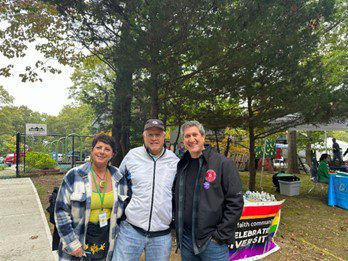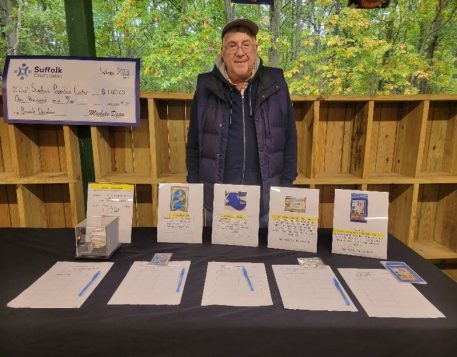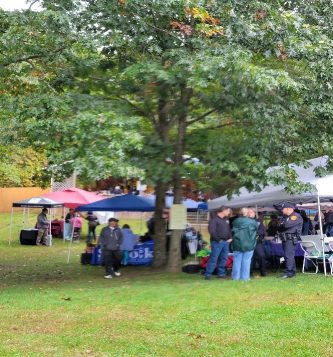Brookhaven highway superintendent candidates take part in office debate
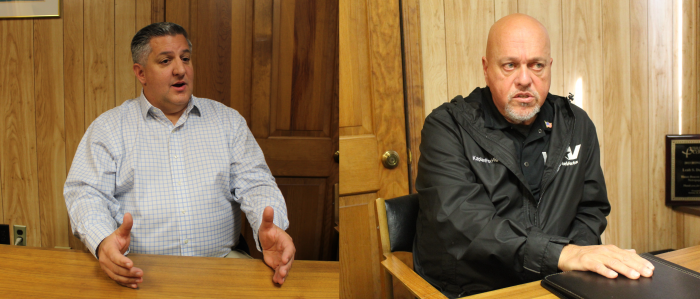
By Aidan Johnson
As Election Day nears, residents will decide between two candidates for Town of Brookhaven highway superintendent.
Current highway superintendent, Dan Losquadro (R), and Michael Kaplan (D) took part in an exclusive debate at the TBR office Friday, Oct. 27, tackling issues such as response times, paving schedules and the impact of storms on roads.
Introductions
Losquadro has served as highway superintendent for almost 11 years but has held public office for roughly two decades.
He started out after winning a special election in 2003 for Suffolk County’s 6th Legislative District. After serving two years in the Legislature, his colleagues elected him to be the Republican Conference Leader at age 33. He gave the rebuttals to Suffolk County Executive Steve Levy’s (D) State of the County address at that time.
He moved on to serve in the New York State Assembly but preferred staying home with his family. After people started lobbying him to replace former Highway Superintendent John Rouse (D), Losquadro decided to do so, citing his past work in his father’s body shop and as a laborer with Local 66 as what trained him for the job.
Kaplan has had 30 years of experience in municipal highway departments, serving 20 years in Islip and 10 years in Huntington. During that time, he served as a laborer, road inspector and worked directly for the superintendent of highways in Huntington. Additionally, he has served as a union leader and is a U.S. Army veteran.
While Kaplan indicated he did not want to speak negatively about Losquadro, he said that he has differing opinions on how to run the department and that there have been “a lot of residents” who have told him that they wish to see the superintendent more often.
Functions of the office
Losquadro said that the “umbrella of the Highway Department is much larger than people realize.” It is not just about the care of the roads but includes areas such as the traffic safety division for the town, engineering where all highway work permits go through, stormwater management and street lighting.
Losquadro runs a budget of more than $110 million, has nearly 300 employees, oversees 3,500 lane miles of roads and believes in innovation for moving the department forward, citing his digitizing of the work order system along with the conversion of all of Brookhaven’s street lights to LEDs, with Brookhaven’s energy savings being up to $1.2 million a year.
He has also brought in over $150 million from the state and federal grant funding to the town, including a $16 million grant to replace the Sheep Pasture Road bridge in Port Jefferson Station earlier this year.
Kaplan stated that Losquadro touched on a lot of the functions. However, he said that after knocking on thousands of doors, he has a different perspective on how the Highway Department should be run daily.
Kaplan said that the workforce needs to be built back up, both in the sense that it is not enough and because it is demoralized. While he noted Losquadro has done a good job, Kaplan also stated that there are many residents who are frustrated with a perceived lack of accessibility and poor response time within the department, along with people not receiving an answer to their concerns.
As the head of the department, Kaplan said he would be talking to the employees and residents “every single day” and explain to them the answer to their problems, “whether they like my answer or not.” Kaplan also believes that he has to have a staff with the same vision of public service and that while the employees come first, “it’s really all about the residents.”
Losquadro rebutted this, saying he is “as hands-on as it gets” for a highway superintendent and that he and his staff deal with residents “day in, day out.” However, he said that one of the problems is that some people will call other local officials if they do not like the answer the Highway Department gives them, and claim that they did not get a response. However, the electronic work order system can show that the department has been in touch. While they sometimes miss the mark, he indicated, they still strive to contact every person promptly.
Climate change
With climate change increasing the threat of environmental disasters, including major snowfall events, Kaplan believes that it is imperative to build up private contractors.
Kaplan also said that road sweeping is a vital part of conserving the environment because if the road is not swept, everything washes down into the catch and recharge basins, polluting the aquifers.
While there hasn’t been a big snowstorm in recent years, Kaplan said one big snowfall is enough to remind everyone that what the department does is vital. He also said that there is a science to snow plowing that he would teach every individual what to do behind the wheel of a truck.
Kaplan also said that, with a larger workforce, he would want to have a snow plowing operation that encompasses all of the roads, both main and side, at the same time.
Losquadro noted that climate change has also caused issues such as roads that were once dry at high tide to now be underwater at normal tide. Because of this, Highways has worked with the Law Department and has abandoned a number of roads.
Due to rising sea levels, Losquadro has been “seeking grants anywhere I can get them.” Currently, the department is raising the roads along Mount Sinai Harbor and doing a massive drainage project there so that the roads remain passable at high tide when water gets impounded in the harbor along the southern shore.
Since there is no capacity for drainage along the southern shore, the department has been acquiring parcels and using them as bioretention areas to make the roads passable.
Losquadro has also increased the rate paid to snow plow vendors by 25% this year. However, the department is facing a problem that the younger generation of contractors is not getting into the snow plowing business, so is trying to incentivize outside contractors.
Response times
Losquadro elaborated on the electric work order system he put in place, describing how a variant is used during severe weather events, containing “a simple dropdown menu” with which they can put information into quickly.
Additionally, a foreman can use iPads during a work order to take pictures and type in their notes to transmit the information instantly to a customer service representative, who can then relay it back to the resident in cases such as evaluations and inspections.
The department has also added the ability to track all of the road signs in its geographical information system and have added almost 200,000 drains. Losquadro said they “continue to add functionality to the system and build on it” to be more efficient.
While Kaplan said that he respects what Losquadro had to say, if elected, he would go back to the “old school way of doing things” by being a “boots on the ground” superintendent immediately.
If someone calls with a concern, including issues of potholes, Kaplan said he would institute a 72-hour correspondence policy, meaning that the person calling would receive correspondence, such as a callback or email, explaining that their issue has been recognized, and then a time to have it repaired will be scheduled.
Additionally, Kaplan said that potholes would be filled and repaired within 48 hours, and he would reteach his employees how to fill a pothole by his standards.
Politicization claim
In response to claims that Losquadro only begins to fix roads and potholes right before an election, Losquadro considered this notion “absurd.” He further said that the paving season runs from April to November, with someone being first and someone being last during the paving season.
According to the incumbent, they schedule the work based on how much concrete or drainage work has to be performed on a given project, with the jobs that require less work being done in the spring since they can get the prep work done sooner. Anything involving schools is done over the summer so as not to disrupt access to the schools, and the projects done in the fall require more extensive concrete or drainage work.
Losquadro also said that they spend nearly the same amount of money each year, exclusive of grant funding for individual projects, and do not spend more during an election year.
While Kaplan did state that he did make a comment about allegations that Losquadro only begins to fix potholes and roads around election time, he did not mean that as a disrespectful comment toward Losquadro. He had made the comment because residents have told him that they would repeatedly ask for an issue to be addressed, and it would only happen “three months before an election.”
Paving schedules
Kaplan said that he would have a delegation involved in assessing all of the roads in Brookhaven since the highway superintendent could not feasibly do it by themself. He would have the roads rated A through F, with the roads receiving “D” and “F” ratings being placed on the high-priority list.
Losquadro said that prioritizing a roadway isn’t just “necessarily a visual assessment” since there may be cases where the top layer of a road may appear to be in disrepair while the subsurface is still very strong, and vice versa.
If reelected, Losquadro pledged to avail himself of a program offered by the Cornell Cooperative Extension that uses optical sensors to evaluate the condition of the town’s roads to get what he referred to as a “heat map.”
Losquadro added that he feels that they have gotten through the roads that were in very poor shape that he inherited from the last highway superintendent. He is planning two-to-three years out in the paving schedule, which is why the overall optical evaluation of the roadways would be helpful in how he looks forward at a possible three-to-eight years out from this point.
Brookhaven residents townwide will decide on the Highway Department’s future on Tuesday, Nov. 7.
D. None of the Above: As role models, parents can help create a better world for our children
By Daniel Dunaief

My wife and I used to say “the recording is always on.”
It was our code words to each other to be careful about what we said and did in front of our children, particularly when, as many parents know, we might not want our children to act or speak in the same way we might be tempted to in the moment.
Our children have an incredible ability to monitor everything we do, even when they don’t appear to be paying any attention to us. Sometimes, they actively choose the opposite because our choices annoyed or frustrated them.
If, as many of us say and believe, we want our children to be better than we are, we wish them well, wait and watch, hoping their happiness, success and achievements far exceed our own.
Perhaps such reaction formation is what brings grandparents and grandchildren together, causing various characteristics to skip a generation, as two opposites create the same.
Aside from things like weekly routines, an emphasis (or not) on achievements like community service, or performance in sports or music, parents recognize that we are role models.
In the movie “42” about trailblazer Jackie Robinson, the first African-American man to play in Major League Baseball, a father shouts racial epithets at Robinson, leading his conflicted son to ponder how to behave. The son echoes what his father shouts.
In that moment, Peewee Reese puts his arm around Robinson, offering his public support and quieting the hostile crowd. Reese even suggests, as a nod to the realities of today, that “Maybe tomorrow we’ll all wear number 42. That way they won’t tell us apart.”
Films are great, but we don’t live in a world where supportive music and smiling heroes remind us who we are or how we should act.
It’s up to us to decide how to be better for ourselves and for our children.
A friend recently shared a story about his daughter. A college student, she was working at an ice cream store during a fall break. A few customers came in and a man in the group asked her where she attended college.
When she told him, the man suggested that there were Muslims who attended that college and it would be easy enough to take a few of them behind the shed and get rid of them.
The man who made a joke about murder at a time of violent conflict in the Middle East and ongoing and hostile disagreements among Americans probably wasn’t thinking about his children, about my friend’s daughter, or anyone else.
Maybe he was repeating the words his father or mother said at the dinner table, after an evening of drinking or within minutes of leaving a house of worship.
Is that the person he wants to be? Is that what he would encourage his own children to believe, that people who practice other religions or have other beliefs are somehow such enemies that it’s okay to make such a comment?
We have to be better than that. Maybe the guy didn’t mean it, but even saying it suggests that he not only thought it, but that he also likely shared that idea in some context in front of his children.
Killing and hatred won’t end if we don’t hold ourselves accountable for our actions and words.
We identify ourselves in particular ways, by such factors as nationality, religion, race, among many other labels.
Those identifiers, many of which we didn’t choose but are an accident of our birth, mean that others around us are on the outside, associating with a different group.
We owe it to our children to imagine and create a better world. That starts by serving as role models and not as reflexive perpetuators of anger, hatred, or prejudice towards those we consider others.
With the world echoing the conditions from the 20th century, we should speak and act in ways that bring people together and that would make us proud if and when we heard our children making those same, or perhaps better, remarks.
Between You and Me: Election special from TBR News Media
By Leah S. Dunaief

Inside this issue is a treasure trove of first-hand information about the candidates and the issues in the coming election. How do I know? Because we, the different members of the editorial board of Times Beacon Record Newspapers, personally interviewed 25 people running for office across the three towns that we serve: Brookhaven, Smithtown and Huntington. The offices the candidates are running for are all local, which means that these are the officials who will have the most direct effect on our lives.
The positions range this year from county legislators to town supervisors, town council, and town clerk. We asked them questions without bias, seeking only to understand who they were, what they believed and what we could expect from each of them, should they be elected — or re-elected, as the case might be. The setting in our conference room was relaxed, and we hoped comfortable, with opponents for each office seated together around the table responding to questions put to them by our editors and reporters.
Sometimes there were four candidates, sometimes only one who might be running unopposed or against a shadow opponent, but mostly there were two during each session. Most of the time, the hour goes by calmly, but occasionally the opponents get testy with each other — they may even become openly hostile.
At one such session some years ago, one of the candidates invited the other out to the back parking lot “to settle things.” When the other began to take off his jacket, we quickly intervened. But there were no such flare-ups this year.
The answers were timed in an attempt to get to the main ideas without running on too long. There was ample time at the end for each visitor to tell us anything more that perhaps we hadn’t elicited with our questioning.
We have written up the details of each interview in a separate article for the election section. And we discuss the candidates at the end of each hour and come to a conclusion for the endorsement.
Most of the time, the editorial group was unanimous because the choices were fairly direct. But for a couple of races, we talked over the pros and cons of each candidate at length before making the selection. These endorsements are based on both the in-depth interviews and the considerable information we know about the incumbents since we have been covering them closely throughout their terms in office. Of course, after reading the stories, you may or may not agree with our conclusions. Our job is to get you thinking.
The many hours that are given to this task, throughout the month of October, are a service for our readers. We are privileged to enjoy an extended face-to-face time with those standing for election, and we feel an obligation to pass along whatever information, facts and impressions we gather during these sessions. We sincerely hope we help in the sometimes-difficult job of casting a responsible vote.
Each year we include in the election section a sample ballot that we are able to procure from the Suffolk County Board of Elections because readers have told us that it is a great advantage for them to receive the ballot at the voting poll already knowing how it is laid out.
Our editorial board is made up of staffers with different political leanings, but when we put our journalists’ hats on, we try to judge each race strictly on the merits of the opposing candidates. And while it is technically possible for me to be tyrannical about the final selections, that is almost never the case. We decide by majority rule.
Sincere thanks to the talented staff who join in this extra work each year. We truly believe that we are watchdogs for the people, and nowhere is that more necessary than in reporting about government and its office holders. We hope we have helped you, whether you read by newspaper and/or online. Now please vote.
Overwhelming support for Sunshine Prevention Center’s 1st Fall Family Festival
Despite challenging weather conditions, more than 50 vendors, including crafts people, local businesses and Community agencies braved the elements and participated in the Sunshine Prevention Center’s Fall Family Festival in Port Jefferson Station on October 14.
In addition to vendors and supportive agencies, there were over 60 raffle prizes and a unique variety of auction items. For children, there was face painting, balloon making and bouncy houses, courtesy of Tent Pro.
Overall, the event provided a wonderful venue to network, educate and spread the word about community services, and working together towards common community concerns focused on students and their families. One example of this is the 65 Narcan kits that were handed out by the Suffolk County Police Department and their training of at least 100 individuals. These kits save lives.
All in the name of fun for a cause, all proceeds benefit Sunshine’s Fall programs and holiday assistance programs. In addition, the monies collected and donated to the event go to specific programs offered through this important non-profit organization. These include newly formed evening programs focused on students and their families. The monthly parent support/educational workshop series will present a different topic run by different professionals.
In a press release, the organization thanked Nancy Campo who was responsible for all the raffles; Robert Cohen, Sunshine Prevention Board’s President, who donated sports memorabilia for the silent auction; Town of Brookhaven Councilmember Jonathan Kornreich and Hank Heissenbuttel of Long Island Charities Foundation for their ongoing support of Sunshine’s mission and programs; and the Suffolk County Youth Bureau.
Sunshine Prevention Center is located at 468 Boyle Road, Port Jefferson Station. For additional information about their programs, visit www. sunshinepreventionctr.org, call 631-476-3099 or email [email protected].
SBU names Pierce Native American Studies director, plans new hires
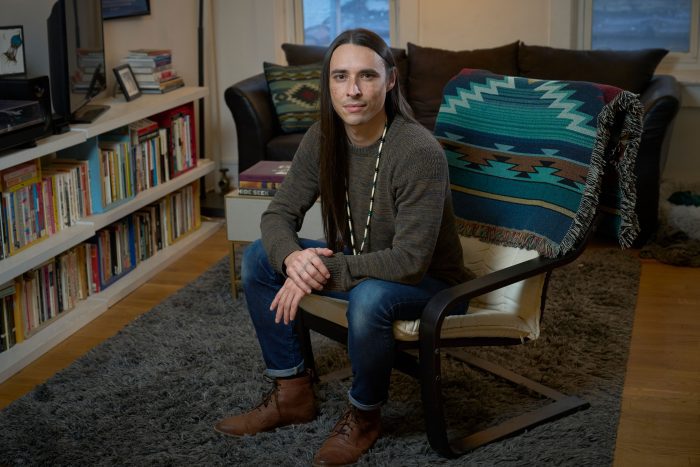
Stony Brook University named Joseph Pierce, associate professor in the Department of Hispanic Languages and Literature, the inaugural director of a Native American and Indigenous Studies effort as the university plans to hire three new faculty in this nascent undertaking.
Next year, the southern flagship school of the State University of New York plans to add staff in the English Department, Women’s Gender and Sexuality Studies and Anthropology.
“I have been eager for this to start,” said Pierce, a member of the Cherokee Nation who has been at the university for a decade. “We have so much to contribute to broader discussions that are happening around the world. The university is better by including Native American studies.”
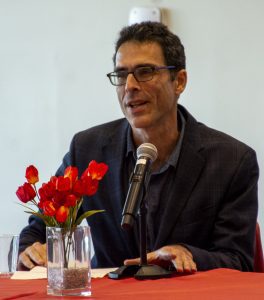
Andrew Newman, professor and current chair of the Department of English, who is also chair of a committee advising Axel Drees, interim dean of the College of Arts and Sciences, described Pierce as having a “real national profile,” adding that he was the “right person to be the founding director.”
Starting next fall, students at the university can minor in Native American and Indigenous Studies, where they can study the history, art, social and political interests, languages and cultures of Indigenous peoples.
The focus on Native American Studies will emphasize transdisciplinary topics such as environmental justice and sustainability.
Earlier this year, Stony Brook won a competition to develop Governors Island as a climate solutions center [See story, “SBU will develop $700M climate center on Governors Island,” April 26, TBR News Media].
Indigenous scholars should have a “seat at the table,” said Newman, “as they are globally one of the demographics most impacted by climate change.”
Islands in the Pacific are disappearing, Guam is undergoing “significant environmental degradation,” and fires in the Pacific Northwest and leaking pipelines in the United States and Canada are “disproportionately affecting Indigenous peoples,” Pierce added.
Indigenous groups relate to the land in a way that’s different from others, approaching it as stewards and caretakers, Pierce said.
“We see land as a relative,” he noted. “We’re asking very different questions about what it means to care for a place and to care for the environment and to care for the life that sustains it.”
The New York City government proposed plans for flood relief on the lower East Side of Manhattan in the event of future storms like Hurricane Sandy. The proposals included building massive walls and raising elevated platforms, including clearing thousands of trees.
Numerous indigenous groups objected and protested against such plans, Pierce said.
In an email, Carl Lejuez, Stony Brook University’s provost, suggested that a significant piece of Governors Island is climate justice, so the link between the Governors Island effort and indigenous peoples “fits naturally with the goals of the New York Climate Exchange.”

Lejuez credited Drees as a “driver of this in collaboration with Professor Pierce.” Lejuez added that his office is “definitely providing support to see it come to fruition.”
The most crucial component in the start of this effort is hiring faculty.
“If we build the core faculty across the university, we can definitely consider expanding research and curriculum opportunities,” Lejuez wrote.
Student interest
Students from the Anthropology Department recently invited Pierce to give a talk about some of his current research.
“It was evident that a lot of them have an interest in working toward understanding humanity, what it means to be human,” he said. They also have an understanding of how anthropology as a discipline has sometimes historically “adopted rather unscientific and proto-eugenic methods” in describing and analyzing Indigenous Peoples.
Students are eager for an alternative perspective on the acquisition and acceptance of knowledge.
Pierce believes students have considerable interest in Native American Studies. His courses about Latin American indigenous populations are full.
“There are numerous students who are interested in Native American and Indigenous studies but don’t quite have a cohesive plan of study that’s available to them,” Pierce said. “This is remedying that disconnection.”
Long Island students grow up in numerous towns and communities with Native American names, such as Sachem, Wyandanch, Montauk and Setauket.
Newman added that the staff hopes the new effort can do some “outreach to local schools and provide professional development with kindergarten through 12th-grade teachers. It would be an important mission for the university to educate Long Island as a whole about Native culture.”
Happy Halloween from TBR News Media
HAPPY HALLOWEEN!
From all of us here at TBR News Media, have a SPOOK-tacular day!
From Scottish rituals to pumpkin wonderlands: Long Island’s haunting Halloween evolution
By Nasrin Zahed
Halloween has a rich history on Long Island that dates back to the early colonial days. Over the centuries, it has evolved from ancient Scottish rituals to the modern-day extravaganza of costumes, candy and spooky spectacles.
Halloween’s origins can be traced back to the ancient Scottish festival of Eve of All Hallows, celebrated around the end of October. Though commonly believed to be derived from the Celtics, Henry Kelly, distinguished research professor in the Department of English at the University of California, Los Angeles, has provided the research to debunk such a claim.
“People in Ireland also indulged in similar festivities on the day before All Saints’ Day, including divination games and competitions like apple bobbing,” said Kelly in an email exchange.

Halloween customs came to America primarily through the Irish immigrants in the 19th century. The practice of carving Jack-o’-lanterns, a staple of modern Halloween, is often attributed to Irish immigrants who brought the tradition of carving turnips with them. The orange pumpkin, native to North America, became the go-to canvas for spooky faces and designs.
Though of all the traditions to be brought over, dressing up on Halloween and going door to door is still a bit hazy. “The question of when children started masquerading and going around for treats at Halloween in America needs further research,” Kelly said.
Regardless, Halloween has adapted to become one of the most profitable holidays of the year. Seeing as the United States has a strong consumer culture, Halloween became an opportunity for retailers to tap into this market. Businesses saw the potential in selling costumes, decorations, candies and other Halloween-related products.
There is no question that Long Island has found a niche in that market as fall makes Long Island a scenic destination for all things fall fun.
With its agricultural history, Long Island is also home to numerous farms and pumpkin patches, where families can pick their own pumpkins and enjoy fall-themed activities. Others can enjoy an array of haunted attractions and houses that draw thrill seekers and horror enthusiasts during the Halloween season. Places like Darkside Haunted House in Wading River and Gateway’s Haunted Playhouse in Bellport offer terrifying experiences for those brave enough to enter.
Long Island boasts numerous historical sites with eerie legends and ghost stories.
One of the standout Halloween events is the Rise of the Jack O’Lanterns at Old Westbury Gardens, showcasing thousands of intricately carved pumpkins, transforming the gardens into a mesmerizing pumpkin wonderland. The event is being held through Nov. 2.
Local businesses and communities have embraced the spirit of Halloween, with businesses decorating their storefronts and residents adorning their homes with creative and spooky decorations.
Hailey Hamilton of Old Wood Road, Stony Brook, shared her thoughts on the upcoming holiday, saying, “Halloween in our town is always a blast. The decorations go up, the costumes come out, and the spirit of the season is infectious. It’s the perfect time of year to enjoy some spooky fun with friends and family.”
A fascinating tapestry of ancient Scottish customs, early American traditions and modern-day festivities, Halloween on Long Island is the one to beat. A bewitching experience for all ages, Long Islanders have embraced this holiday with open arms, making it an integral part of their culture.
If you find yourself on Long Island in late October, be prepared for a ghoulishly good time.
Port Jeff Village announces closure of Harborfront Park for walkway repair and renovation

The following is a press release from the Village of Port Jefferson:
Apologies for any inconvenience.
Port Jefferson’s Harborfront Park will be closed to the public from Oct. 27 to Jan. 1, 2024 for the replacement of the park’s walkways.
For safety reasons, we ask that the public not visit the park during the ongoing construction.
Look for construction and park reopening updates on social media and on the official village website: www.portjeff.com.
Please contact village clerk Sylvia Pirillo at 631-473-4724 ext. 219, or by email at [email protected] with any questions.
Thank you for your patience while we build a beautified, more accessible and safer Harborfront Park for all our residents and visitors.
Editorial: Informed voters, effective officials — Why local elections matter
While every election is important, we take special care in informing our readers ahead of local races. With Election Day — Nov. 7 — fast approaching, we remind our readers why voting in local town and county elections is critical.
Unfortunately, many Americans today are losing faith in our democratic norms. Everywhere we look, we see partisanship, tribalism and polarization undermining our political process. National media sources often feed into and inflame these divisions for monetary and partisan gain.
Lower levels of government can offer a powerful counterbalance to all of this noise. Both literally and figuratively, local officials are closer to the people — their seats of government are located within our communities, and their decisions more immediately influence our day-to-day lives.
The issues debated by local legislatures are often far removed from the political theater observed in Washington and Albany. Local elections are not about the national debt ceiling, universal free health care or American foreign policy — remote if important issues in our ordinary lives.
Local elections are about us and the complexion of our community. They determine land use and zoning policies within our neighborhoods and commercial districts, drainage and related wastewater infrastructure investments, waste management services, park access, street paving and much more. Local elections determine the granular matters which shape our relationships to our surrounding area.
We remind our readers to be especially wary of candidates and commentators who inject national issues into our local dialogue. Those who do so are often ideologically driven, engaged in illicit political posturing.
We advise prospective voters to begin researching their ballots thoroughly. A functional local democracy requires a well-informed, enlightened electorate. And the more informed we are collectively, the better our elected officeholders will be.
When considering a candidate for local office, we should never decide based on party affiliation alone. This one-dimensional voting strategy cheapens our votes, outsourcing our decisions to the party bosses who handpick the nominees on our ballots.
We must ask ourselves whether a candidate possesses the requisite professional experience and knowledge to advance our interests. We must ask whether their values align with our own. And we must determine whether a candidate is running to promote the public good or to serve their self-interest.
Next week, TBR News Media will release its annual election supplement. Through interviews with various local candidates across our coverage area, we hope our readers will enter the voting booth better equipped to make informed judgments. We will also offer endorsements for candidates who best reflect our staff’s values.
With less than two weeks to go, we must get serious about our votes — because local elections matter.







